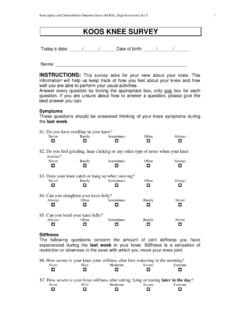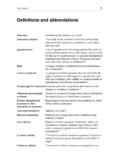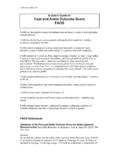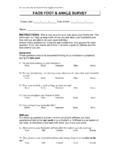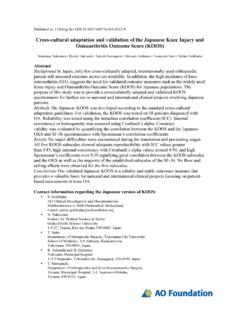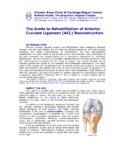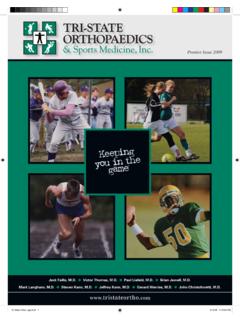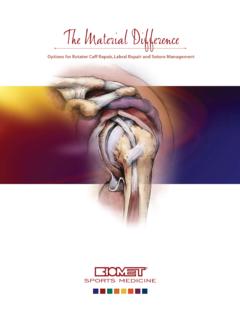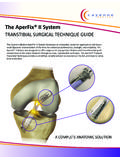Transcription of A User's Guide to: Knee injury and Osteoarthritis …
1 KOOS User's Guide 2003 A User's Guide to: knee injury and Osteoarthritis Outcome Score KOOS KOOS is developed as an instrument to assess the patients opinion about their knee and associated problems. KOOS is intended to be used for knee injury that can result in post traumatic Osteoarthritis (OA); ACL ( anterior cruciate ligament ) injury , meniscus injury , chondral injury , etc. KOOS is meant to be used over short and long time intervals; to assess changes from week to week induced by treatment (medication, operation, physical therapy) or over years due to the primary injury or post traumatic OA. KOOS can be used to assess groups and to monitor individuals.
2 KOOS content validity was ensured through literature search, a pilot study and an expert panel (US and Sweden); patients, orthopedic surgeons and physical therapists. KOOS consists of 5 subscales; Pain, other Symptoms, Function in daily living (ADL), Function in sport and recreation (Sport/Rec) and knee related Quality of life QOL. The last week is taken into consideration when answering the questions. Standardized answer options are given (5 Likert boxes) and each question gets a score from 0 to 4. A normalized score (100 indicating no symptoms and 0 indicating extreme symptoms) is calculated for each subscale. The result can be plotted as an outcome profile.
3 KOOS is patient-administered, the format is user friendly, and takes about 10 minutes to fill out. KOOS is self-explanatory and can be administered in the waiting room or used as a mailed survey. KOOS has been used in patients 14-78 years old. KOOS reference values from a group of 50 subjects (mean 53 years, 37-79) with no previous and no current clinical signs of injury to the ACL or menisci and no radiographic signs of OA has been established [1]. KOOS has high test-retest reproducibility (ICC > ). KOOS includes WOMAC Osteoarthritis Index LK [2] in its complete and original format (with permission), and WOMAC scores can be calculated.
4 WOMAC is valid for elderly subjects with knee OA. KOOS User's Guide 2003 2 KOOS construct validity has been determined in comparison with SF-36 [3, 4] and expected correlations were found [5-7]. Moderates to high correlations were found when comparing to the Lysholm knee scoring scale [6]. KOOS subscales "Sport and Recreation function" and "Quality of Life" were more sensitive and discriminative than the WOMAC subscales "Pain", "Stiffness", and "Function" when studied in subjects meniscectomized 21 years ago and with definite radiographic signs of OA (mean 57 years, 38-76) compared to age- and gendermatched controls [8]. KOOS responsiveness has been determined in three separate studies.
5 Significant improvement was found after reconstruction of the ACL [7], after physical therapy [7], three months after arthroscopic partial meniscectomy [6] and 6 months after total knee replacement [5]. High effect sizes (mean score change/preoperative SD) were found, indicating fewer subjects needed to yield statistically significant differences. KOOS validation work is ongoing. KOOS is currently being used in several clinical studies involving patients with meniscus injury , ACL- injury , cartilage injury , and post-traumatic Osteoarthritis (for current update search PubMed using KOOS + knee ). Several methodological papers regarding the KOOS have been published [5-8].
6 KOOS is currently available in the following versions, American-English, Swedish, Danish, and German. Unvalidated versions in Italian and Russian are available. The validation work of French and Spanish versions are ongoing. KOOS information can be required from: Ewa Roos PT PhD, Department of Orthopedics, Lund University Hospital, S-221 85 Lund, Sweden. Fax: int+46(46) 13 07 32 E-mail: REFERENCES 1. EM Roos, M Klassbo, LS Lohmander: WOMAC Osteoarthritis index. Reliability, validity, and responsiveness in patients with arthroscopically assessed Osteoarthritis . Western Ontario and MacMaster Universities. Scand J Rheumatol 1999, 28:210-5.
7 2. N Bellamy, WW Buchanan, CH Goldsmith, J Campbell, LW Stitt: Validation study of WOMAC: a health status instrument for measuring clinically important patient relevant outcomes to antirheumatic drug therapy in patients with Osteoarthritis of the hip or knee . J Rheumatol 1988, 15:1833-40. 3. JE Ware, Jr., CD Sherbourne: The MOS 36-item short-form health survey (SF-36). I. Conceptual framework and item selection. Med Care 1992, 30:473-83. 4. JE Ware, Jr., K Snow, M Kosinski, B Gandek: SF-36 Health Survey Manual and Interpretation Guide . Boston, MA: The Health Institute, New England Medical Center; 1993. KOOS User's Guide 2003 35.
8 E Roos, S Toksvig-Larsen: knee injury and Osteoarthritis Outcome Score (KOOS) -validation and comparison to the WOMAC in total knee replacement. Health and Quality of Life Outcomes 2003, 1. 6. EM Roos, HP Roos, C Ekdahl, LS Lohmander: knee injury and Osteoarthritis Outcome Score (KOOS)--validation of a Swedish version. Scand J Med Sci Sports 1998, 8:439-48. 7. EM Roos, HP Roos, LS Lohmander, C Ekdahl, BD Beynnon: knee injury and Osteoarthritis Outcome Score (KOOS)--development of a self-administered outcome measure. J Orthop Sports Phys Ther 1998, 28:88-96. 8. EM Roos, HP Roos, LS Lohmander: WOMAC Osteoarthritis Index--additional dimensions for use in subjects with post-traumatic Osteoarthritis of the knee .
9 Western Ontario and MacMaster Universities. Osteoarthritis Cartilage 1999, 7:216-21. KOOS User's Guide 2003 4 KOOS Reference data - ACL- reconstruction , meniscectomy, and post-traumatic OA KOOS has been used in studies of anterior cruciate ligament (ACL) injury , meniscus injury , and post-traumatic Osteoarthritis (OA). KOOS scores from three of these studies are given to enable KOOS-users to get familiar with the score. To make scientific comparisons, use to the original articles referred to in each section! The data is visualized in graphs. The mean scores for all five subscales are given and connected with a line which gives a KOOS Profile.
10 0 indicates extreme problems and 100 indicate no problems. ACL data (From: Roos E, Roos H, Lohmander LS, Ekdahl C, Beynnon B. knee injury and Osteoarthritis Outcome Score (KOOS) - Development of a self-administered outcome measure. The Journal of Orthopaedic and Sports Physical Therapy 78(2)88-96, 1998. In figure 1 data is given for 21 American subjects (9 males and 12 females) with ACL injury about to undergo reconstruction . Ten of the subjects had a combined meniscus injury . Their mean age was 32 (range 18 to 46). The majority had sustained their knee injury less than 6 months prior to operation. Ten subjects were competing in sports and nine were recreational athletes.)

